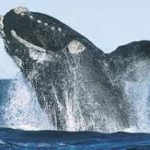The North Atlantic right whale species (Eubalaena glacialis) studied in the Bay of Fundy in Canada, is listed as endangered.
It was believed the species have a dense population a few centuries back but their numbers went down to barely sustainable levels due to hunting by the Basque people.
Recent study suggests the large population decrease took place sooner for reasons that are vague.
According to Dr. Rosalind Rolland of the New England Aquarium in Boston, US, who led the study, the population was now up to an estimated 490 numbers from about 350 a decade ago.
North Atlantic right whales roam up and down the east coast of North America, coming to the Bay of Fundy typically in late summer to feed.
Right whale mother and calves communicate with each other and other whales using low-frequency sound.
But ocean noise has risen substantially in recent decades along with the growth in global shipping; one analysis showed that the north-eastern Pacific is 10-12dB louder now than in the 1960s.
Past years have seen significant numbers of right whales hit by ships and entangled in fishing nets.
Noise from ships stresses whales nearby, researchers have noted.
Ships’ propellers emit sound in the same frequency range that some whales use for communicating, and previous studies have shown the whales change their calling patterns in noisy places.
Researchers would now like to establish a study that could relate stress hormones to ocean noise pollution in a range of locations.
Now, researchers have measured stress hormones in whale feces, and found they went up with the density of shipping.
Following the Al-Qaeda attacks on New York and Washington DC on 11 September 2001, ship traffic in the bay dropped off.
Whale researchers registered a 6 decibel (dB) fall in the intensity of underwater noise, with the change particularly pronounced at frequencies below 150Hz.
Feces gathered during the 2001 period of light shipping showed a significantly lower level of metabolites of glucocorticoid hormones, which are associated with stress, than in subsequent summers when marine traffic returned to normal levels.
Incidentally, another team had just begun a five-year project to gather and examine feces from the right whales.
Trained dogs are taken on boats, their noses guiding researchers to the bobbing fecal matter, which is then pulled inboard in nets.
The study could include the differences between the North Atlantic right whales and their close relatives in the southern hemisphere, the Southern right whales, whose numbers are increasing much more vigorously since the era of industrial hunting.
Aquarium scientists have been studying them in the bay since 1980. The new study is reported in the Royal Society journal Proceedings B.
